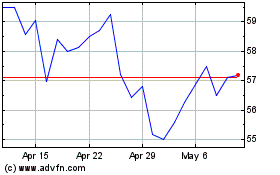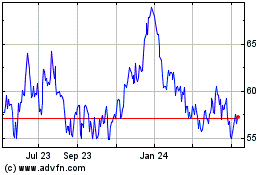BHP Billiton Net Profit Hit by Charges; Earnings, Dividend Jump
August 20 2018 - 6:13PM
Dow Jones News
By Rhiannon Hoyle
SYDNEY--BHP Billiton Ltd. (BHP.AU) said fiscal-year net profit
fell 37% because of one-time charges, but the world's biggest miner
by market value recorded a 33% rise in underlying profit and a
record final dividend, aided by higher prices and production for
most of its commodities.
BHP on Tuesday reported a net profit of US$3.71 billion for the
year through June, down from US$5.89 billion in the 12 months
prior. Weighing on the company's bottom line were US$5.2 billion in
impairment charges, mainly tied to the company's U.S. onshore
oil-and-gas assets, which it has struck deals to sell.
The miner recorded an underlying profit, stripping out one-time
charges, of US$9.62 billion. That was ahead of a US$8.80-billion
median of nine analyst forecasts.
Directors declared a final dividend of 63 U.S. cents a share,
taking BHP's full-year payout to US$1.18 a share, up from 83 cents
a piece the year prior.
"Across our dramatically simplified portfolio of tier one
assets, we see this year's strong momentum carried into the medium
term as our leadership, technology and culture drive further
increases in productivity, value and returns," said Chief Executive
Andrew Mackenzie.
BHP has been enjoying tail winds from stronger commodity prices.
Average prices for its oil, copper and steelmaking coal were up
26%, 23% and 9%, respectively. Iron ore prices were slightly weaker
during the 12-month period, down 3%.
The company has also been producing more. Full-year output of
copper jumped 32%, while production of iron ore was 3% higher and
steelmaking coal was up 7%. Its petroleum division was the outlier,
with an 8% fall in output.
BHP isn't alone in lifting returns to investors. Rio Tinto PLC
(RIO.LN) earlier this month pledged US$7.2 billion in shareholder
returns, including a record interim dividend.
In July, BHP said BP PLC (BP) would buy the bulk of its U.S.
onshore oil-and-gas unit for US$10.5 billion, while it also penned
a separate US$300 million agreement to sell its Fayetteville shale
business in Arkansas to closely held Merit Energy Co.
The company at the time said it would also use that cash for
dividends or share buy backs once the deals were completed in
October. On Tuesday, it reiterated it would confirm how and when
that cash will be used once the sales are completed.
BHP joined the chorus of miners cautioning on cost inflation, as
the industry faces pressure from rising bills for energy and other
necessities.
It also lowered its projection for productivity gains, saying it
now expects savings of US$1 billion in the 2019 fiscal year from a
prior forecast of US$2 billion in the two years through June, 2019.
BHP said the guidance was lowered because of asset sales and
challenging operating conditions at some Australian coal mines.
The company said threats to global economic growth have
increased due to rising trade protectionism.
"Near-term prospects for the U.S. economy are sound, with
cyclical fundamentals solid," BHP said. "However, we expect the
increase in protectionism to weigh on consumer purchasing power and
international competitiveness."
The miner also forecast China's growth to slow modestly in 2018.
Commodity producers face challenges from an easing economy in
China, the top buyer of a lot of natural resources, where spending
on so-called fixed assets such as factory machinery has fallen to
its lowest in nearly two decades.
Write to Rhiannon Hoyle at rhiannon.hoyle@wsj.com
(END) Dow Jones Newswires
August 20, 2018 18:58 ET (22:58 GMT)
Copyright (c) 2018 Dow Jones & Company, Inc.
BHP (NYSE:BHP)
Historical Stock Chart
From Mar 2024 to Apr 2024

BHP (NYSE:BHP)
Historical Stock Chart
From Apr 2023 to Apr 2024
